
Spartina is a genus of plants in the grass family, frequently found in coastal salt marshes. Species in this genus are commonly known as cordgrass or cord-grass, and are native to the coasts of the Atlantic Ocean in western and southern Europe, north-western and southern Africa, the Americas and the islands of the southern Atlantic Ocean; one or two species also occur on the western coast of North America and in freshwater habitats inland in the Americas. The highest species diversity is on the east coasts of North and South America, particularly Florida. They form large, often dense colonies, particularly on coastal salt marshes, and grow quickly. The species vary in size from 0.3–2 m tall. Many of the species will produce hybrids if they come into contact.

Chamidae, common name the jewel boxes or jewel box clams, is a family of marine bivalve mollusks in the order Venerida.

Crassatellidae is a family of small saltwater clams, marine bivalve molluscs of the order Carditida.

Musculus is a genus of mussels in the family Mytilidae.

Musculus lateralis, common name the Lateral mussel, is a small species of bivalve mollusc in the family Mytilidae. It can be found along the Atlantic coast of America, ranging from North Carolina to the West Indies and Brazil.

Musculus niger, or the black mussel, is a species of bivalve mollusc in the family Mytilidae. It can be found in the Atlantic Ocean, eastern Pacific Ocean, and the Arctic Ocean. Along the Atlantic coast of North America, it ranges from the Arctic Ocean to North Carolina.

Euvola is a genus of marine bivalve mollusks in the family Pectinidae, the scallops. In shells of this genus, one valve is flat, and the other is deeply cupped.
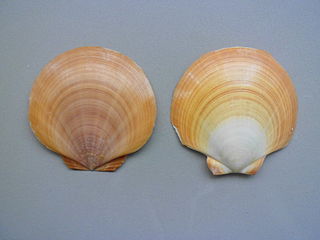
Euvola marensis, or the paper scallop, is a species of bivalve mollusc in the family Pectinidae. It can be found in the Gulf of Mexico, ranging from the West Indies to Brazil.
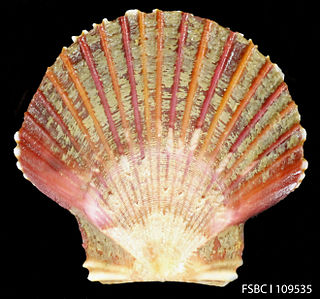
Euvola raveneli, or Ravenel's scallop, is a species of bivalve mollusc in the family Pectinidae. It can be found along the Atlantic coast of North America, ranging from North Carolina to the West Indies.

Antillipecten is a monotypic genus of bivalves in the family Pectinidae. The only species is Antillipecten antillarum, also known as the Antillean scallop. It can be found in Caribbean waters, ranging from southern Florida to the West Indies and Bermuda.
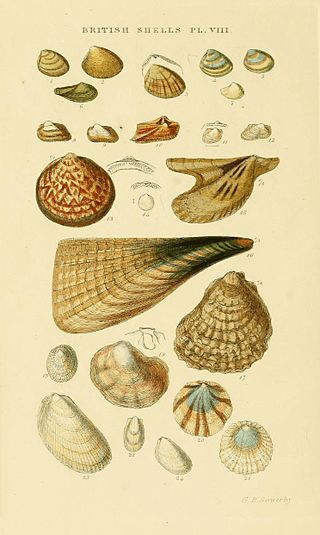
Limaria pellucida, the Antillean file shell, is a species of bivalve mollusc in the family Limidae. It can be found along the Atlantic coast of North America, ranging from North Carolina to the West Indies.
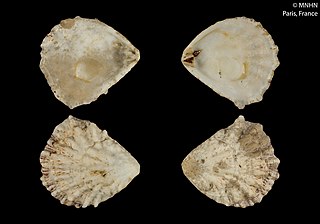
Plicatula gibbosa, commonly known as the Atlantic kitten's paw, is a species of bivalve mollusc in the family Plicatulidae.
Ostrea permollis, the sponge oyster, is a species of bivalve mollusc in the family Ostreidae. It can be found along the Atlantic Coast of North America, ranging from North Carolina to the West Indies.

Astarte elliptica, or the "elliptical astarte", is a species of bivalve mollusc in the family Astartidae. It can be found along the Atlantic coast of North America, ranging from Greenland to Massachusetts.

Lucina amiantus, or the decorated lucine, is a species of bivalve mollusc in the family Lucinidae.
Clathrolucina costata, or the costate lucine, is a species of bivalve mollusc in the family Lucinidae. It can be found along the Atlantic coast of North America, ranging from North Carolina to the West Indies.

Chama congregata, commonly known as the corrugated jewel box clam, is a species of bivalve mollusc in the family Chamidae. It can be found along the Atlantic coast of North America, ranging from North Carolina to the West Indies and Bermuda.

Arcinella arcinella, or the Caribbean spiny jewel box clam, spiny jewel box clam, or spiny jewel box, is a species of bivalve mollusc in the family Chamidae.
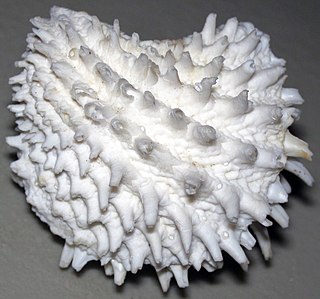
Arcinella cornuta, or the Florida spiny jewelbox clam or Florida spiny jewel box, is a marine species of bivalve mollusc in the family Chamidae. It can be found along the coast of North Carolina to Florida, Gulf of Mexico, Caribbean Central America, and Venezuela.
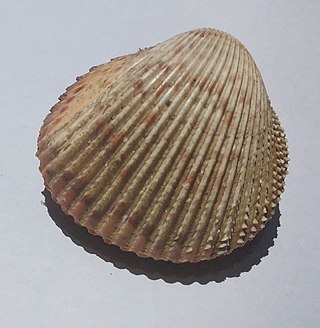
Dallocardia muricata, the yellow prickly cockle, is a species of bivalve mollusc in the family Cardiidae. It can be found along the Atlantic coast of North America, ranging from North Carolina to the West Indies and Brazil.

















